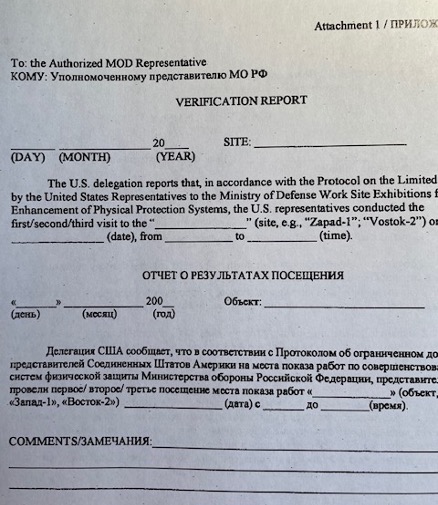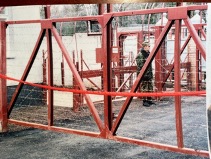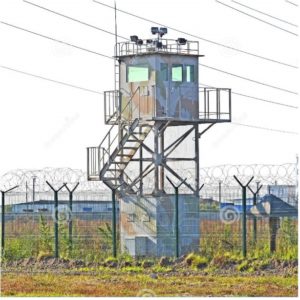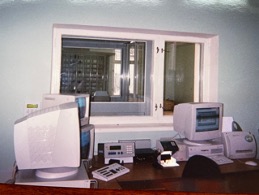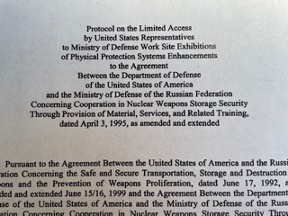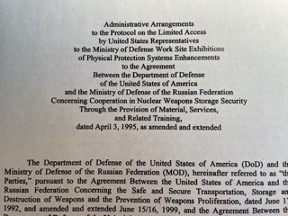
Site Visit Prep
The windows on the Russian van are blacked out with paint and cardboard covers. Four Americans from the Cooperative Threat Reduction (CTR) program climb in and take our seats surrounded by security officers from the Russian Ministry of Defense’s 12th Main Directorate (12th GUMO). Two or three are from the 12th GUMO HQ in Moscow, who we know and have worked with for over five years to make this trip happen, and the rest are strangers from the nuclear warhead storage base we are going to visit. We know better than to sit in the back row because the shocks on the van are so out of date that you’ll hit your head on the ceiling whenever we ride over a bump — and there will be many bumps during the next few hours it will take to get from our hotel to the site. It always takes that long because the Russians take a long and circuitous route over back roads to make sure the Americans won’t be able to recreate the route in our minds later. There is a case of water bottles at our feet, but we know better than to drink anything because when we get to the site we will have only four hours to visit and we can’t afford to sacrifice the 10-20 minutes it would take to use the outhouse that the site has prepared, especially for our visit. My team is under strict instructions to avoid drinking coffee and to minimize fluid intakes since they awoke this morning.
The drive is cold, we can see our breath as we observe our escorts giving us annoying and suspicious looks for putting them through this trip. For some of us, it’s even more uncomfortable because the nice warm American boots we wore to the in-brief were deemed to have some metal in them, so we had to leave them behind and wear the Russian military boots provided by the escorts — or the Russian coat we now have to wear if ours had too many zippers and registered too much metal on the hand-held metal detectors we bought for the guards who used them to give us a full body scan before entering the van.
We try to rest during the drive, but that’s really not possible. We don’t really talk because we’re all trying to remember as much of the equipment we’ve purchased for the site so we can identify it when we get there. We’ve been studying the lists so we can remember what every piece looks like that’s part of the $20-$40M we procured to enhance the security of the site we’re about to visit. The memorization is easier if this is the first time that a CTR team is visiting the site. In that case, we’re just looking to see the conditions of the site, so we’ll know how much work is going to be needed. One of the most interesting things we found during our very first visits was the electrified fencing that surrounded the sites. During early technical discussions, the Russians were interested to see if we were willing to provide electrified fencing. We declined based on the horror story that would ensue if a Russian civilian were accidentally killed by an American-provided lethal electrified fence. We settled on three layers of fencing and sensors instead. If it’s our second visit to a particular site, we’re looking to see if the Russian subcontractors have made as much progress as they reported to the American prime contractor, and more importantly, we’re looking to see if they are installing the systems correctly and conducting the work safely. This will be our third and final trip to the site to see that all the work was done well so we can authorize the contracting officer and the prime contractor to make final payment.
Site Arrival
We can tell when the van arrives at the site because we come to a sudden stop at the end of a particularly rough driving patch. The van doors are flung open, and we can see the light of day for the first time since we left the hotel. We’re greeted by guards with guns, and our escorts provide them with our passports that they collected from us before we left the hotel. We step out to see a tent set up over a table with some refreshments, and an outhouse for our use if any of us haven’t dehydrated enough during the drive. We decline refreshments and use of the outhouse. At this point we usually get to meet the site commander. The site commander is one of the more senior officers in the 12th GUMO, especially if the site is one of the large, central storage sites housing up to a half dozen storage bunkers with perhaps hundreds of nuclear warheads. The site commander is a full colonel, usually outranking all of our escorts.
Over the course of over a dozen site visits, we’ve discovered that first impressions of the site commander can give us a good indication of what we’ll likely see during the site visit. Some site commanders greet us warmly with a smile, a strong handshake for all the team members, and may even thank us for the cooperation provided through the CTR program. Other site commanders only greet our team lead, or maybe won’t even do that, and act as if the visit is a great imposition on their authority. Inevitably, site visits to the bases with these latter-type site commanders are much more likely to exhibit flaws or shortcomings involving the installation or operation of the nuclear security systems provided. These could be things like the exterior fencing that is not quite perfectly erect, or areas where the trees have not been trimmed back far enough from the security fencing, or maybe the operators in the control room might have trouble calling up the screen shots we request during our visit to the central control facility.
As soon as we arrive and are greeted by the site commander, our team lead is handed a Russian watch to keep time of the visit. We have four hours and four locations where we will be stopping to observe the security systems in operation. We’ve negotiated the four locations based on the site diagrams showing the general layout of the equipment that were drawn by the contractors who did the work, along with the most basic of site characteristics. In order to get the best possible impression of the work done by the contractors to install and calibrate the equipment, we negotiate stops at: 1. The external entry/exit gate with a view of the perimeter fencing; 2. Along the perimeter of one of the bunkers where we can also view the external access control system installed at the bunker entrance; 3. At one of the guard posts along a perimeter to see the guard tower; and finally, 4. Inside the control room.
Nuclear Security Observations
One of the first things we learned during our site visits was that the 12th GUMO HQ personnel were using the visit to conduct an inspection of the site on their own. Especially early in the program, the 12th GUMO didn’t have travel funds to visit all of the nuclear storage sites to examine the security systems in person. Not only were we looking to see the condition of the security systems, but the HQ personnel were doing a more complete and thorough inspection as they prepped for our visit. We considered this to be one of the more important functions provided by the program – essentially enabling an independent Russian evaluation of the site security.
Each of the Americans signed a document agreeing not to disclose specific information on the status of the nuclear security system at that site and observed during that visit. Those agreements still apply today, and both Russian and American interests are best served by keeping those specific observations and any vulnerabilities confidential. What we can share, however, is what we were looking for during our visits and what kinds of things we brought to the attention of the 12th GUMO for corrective action – if needed at a particular site.
Entry/Exit Gate: After meeting the site commander and taking possession of the watch provided, the four-hour time limit begins. That means getting back in the darkened van – either the one we came in, or another one provided by the site. The doors close and we’re joined by yet another local escort. This one is usually armed and has a radio to talk to the Russians waiting for us at each stop. The first stop is almost always the main gate to enter the facility. Based on our site diagrams, we know that there is more than one exit gate for the facility, but the other ones are usually emergency exits and not designed for guards to screen incoming foot and vehicular traffic. One of the things we learned from our first several visits was how important it was to bring our own interpreter as a member of the CTR team. With only four personnel allowed, we would debate and discuss team composition for each site visit. An additional nuclear security expert would have been helpful to include on the team, but when the Russians provided an interpreter, we found that the discussions would more often lead to confusion and would consume more valuable time during the visit. CTR Russian interpreters are among the best in the world and having them on the team was critical to an efficient and thorough site visit.
Suddenly we come to a halt and the door is quickly flung open by the Russians stationed at our first stop. The area we are allowed to stand, and view is about the length of a school bus and half as deep. The van or bus blocks our view of most of the site from this location. We can see down the perimeter, looking through the three-layered fencing with microwave detectors and video systems installed in between, and motion sensors in the webbing of the fence. For the next 40 minutes or so, each of us is trying to take in as much of the view as we can and asking questions of our escorts. We’re concerned about the soil condition for the fencing, the snow accumulation in that area, the calibration of the microwave detectors and video cameras, and checking to see that the motion sensors are placed properly, and we look for the little red lights showing the microwaves detectors and cameras powered up. We’ve asked our hosts to have the lighting on, so we know that it works and is placed properly. We settled on lighting the perimeter after long debates on the advantages and disadvantages of fighting in the light or in the dark. Our experts are looking to see that the clear area has been maintained between the fencing and that there are no trees close enough to the outside to enable egress. We’re also looking to make sure there are no signs of animals who may have dug under the fence line or any other disturbances. Finally, we ask them to show us the gate operation.
Bunker Perimeter: Our stop at the bunker perimeter is next. Sometimes we’ll see a separate guard post near the bunker entrance, maybe even a guard with his guard dog. We conduct similar checks on the perimeter fencing, but this time we can see that the fencing appears to go fully around the bunker. We can see the access control system on the door and do our best to see if we can see the light indicating the power is on. There isn’t as much to see here, so we thank our escorts and head to our third stop.
Guard Tower: When the doors to the van open at the third stop, we’re anxious to see the guard tower up close. But upon exiting the van, we can see very little except the outside of the tower and the step ladder that leads up. Camouflage netting is everywhere, so that even as we climb the ladder, we can’t see anything around us. It’s like going up through a tube at a Disney ride, except that we’re somewhere in the middle of Russia surrounded by nuclear weapons. Our hopes of being able to scan the horizon from the guard stand are dashed once we emerge from the climb. There is netting over the bullet-proof glass, so we can’t see outside at all. Instead, all we can see is the inside of an elaborate tree house with rifle and weapons holes for the guards, but even they are covered up so we can’t see outside. About the only thing we can see inside is a portable radio station that we provided for the guards as one of the first, and probably one of the most important, pieces of equipment early on in the program. We were told that the old Russian radios they had were not programmable and often didn’t work for lack of spare parts. As we know from running vulnerability assessment simulations with the 12th GUMO, communications among the guard force is a critical element to increase your probability of successfully fending off an attack.
Control Room: The final stop on our visit is the nuclear security control room. First, we are processed through the access control systems. The site operators actually go through the process of making badges for each of us on site, and we proceed through the screening that all of the operators have to pass through before they go on duty. Of course, we didn’t get to keep the badges afterwards, but we feel like we’re actually a civilian contractor for the 12th GUMO for a moment before turning in the badges.
After going through, we get to watch the video of that process. We finally have a 360-degree perspective, and very little of the equipment is shrouded because it was all provided by the CTR program, including the building itself (or at least its modifications). Now we get to have some fun with the operators by asking them to show us video of when our shrouded bus first approached the facility, and we see the gate open to let in our vehicle. Next, on the video screen we see one of the Russian security guards within the clear area of the perimeter fencing. He touches the fencing, and we see the fence disturbance indicator alarm go off and he does the same thing for the microwaves. We look carefully to see if there is any lag time – even a few seconds – before the alarm is set off. We know this is important to make sure the alarm activates the video camera instantly. We know that this is being done in real time because we provided him with a sign with the DTRA sticker on it and with the signature of our team lead before we got off the bus, and we can see him holding up the unique identifier on the screen. The operator scrolls through video shots of other perimeter areas so we can see a good portion of the site. It’s hard to tell how much we are actually seeing, but our security experts have a good idea how many video cameras we bought for the site and we can estimate how much of the perimeter we’re actually seeing. We’re also concerned with making sure all the air conditioning and heating systems are working properly and ask the operators about those systems to make sure the equipment is not exposed to heat or cold in an effort to save money on utilities. We then ask them to demonstrate activation of the back-up generator system to show that the equipment comes on-line instantly if there is a power loss. What’s the most striking part of this portion of the visit is that there is little or no evidence of any security systems anywhere on the site that weren’t provided by the CTR program. Unlike arms control inspections and visits to other sensitive sites we’ve experienced, there is no shrouded equipment we can see or signs that equipment has been removed from the control room. We are pleased to see the systems up and running and seeing trained and dedicated operators in action. We wonder a little what security would have been without all the cooperative efforts put forth. Thankfully, we’ll never know that answer.
We wrap up the four-hour visit, returning to the tent just outside the facility for a much-needed visit to the outhouse and a few refreshments before hitting the road and returning to the hotel. We sign a couple of documents: one agreeing not to publicly release any information on that specific site visit; and the other signed by the team lead noting that we were able to see everything that we had agreed on. If we have any concerns identified during the visit, such as a task that wasn’t completed on site, or something that didn’t work properly, we note it on the document. During our visit, we asked many questions of the site operators and personnel, and we noticed the 12th GUMO HQ escorts paying close attention to every word. We also notice when they are asking their own questions or giving directions to the site personnel or the Russian subcontractors during the visit. Another site’s security is upgraded, and we tip a glass as the 12th GUMO takes over responsibility to sustain nuclear security for one of the largest nuclear warhead storage sites in the world.
